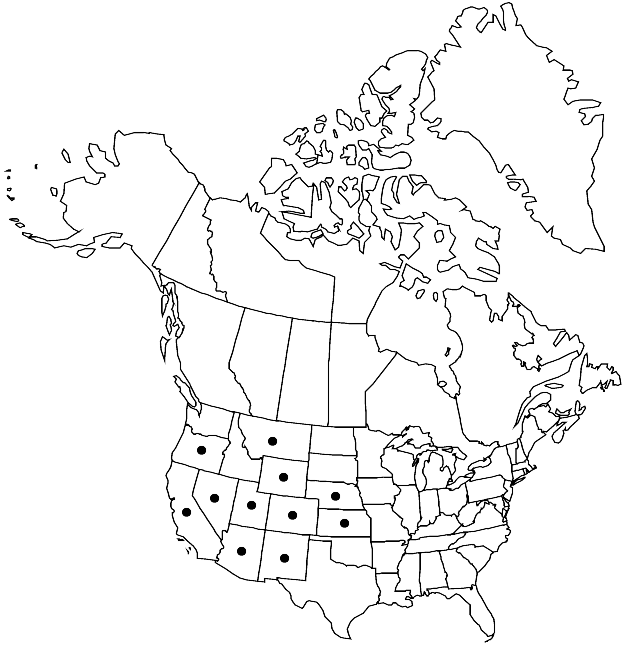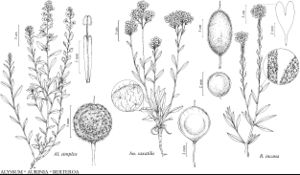Difference between revisions of "Alyssum simplex"
J. Bot. (Schrader) 1799(2): 290. 1799.
FNA>Volume Importer |
FNA>Volume Importer |
||
| Line 26: | Line 26: | ||
|elevation=1400-2400 m | |elevation=1400-2400 m | ||
|distribution=Ariz.;Calif.;Colo.;Kans.;Mont.;Nebr.;Nev.;N.Mex.;Oreg.;Utah;Wyo.;Europe;c;sw Asia;n Africa. | |distribution=Ariz.;Calif.;Colo.;Kans.;Mont.;Nebr.;Nev.;N.Mex.;Oreg.;Utah;Wyo.;Europe;c;sw Asia;n Africa. | ||
| − | |discussion=<p>Almost all European and North American authors, including T. R. Dudley (1964) and R. C. Rollins (1993), have used the name Alyssum minus (Linnaeus) Rothmaler for this species. Rothmaler made his new combination based on the nomen nudum Clypeola minus Linnaeus and cited A. campestre Linnaeus as a synonym. Therefore, that combination is illegitimate, and the species should be known as A. simplex, the earliest valid and legitimate name.</p><!-- | + | |discussion=<p>Almost all European and North American authors, including T. R. Dudley (1964) and R. C. Rollins (1993), have used the name <i>Alyssum</i> minus (Linnaeus) Rothmaler for this species. Rothmaler made his new combination based on the nomen nudum Clypeola minus Linnaeus and cited A. campestre Linnaeus as a synonym. Therefore, that combination is illegitimate, and the species should be known as <i>A. simplex</i>, the earliest valid and legitimate name.</p><!-- |
| − | --><p>Most of the North American records of Alyssum strigosum are based on misidentified plants of A. simplex. The two species are similar in nearly all aspects except for trichome morphology of the fruit. In A. simplex, all fruit trichomes are stellate and occasionally some trichomes have rays coarser than the others. By contrast, the fruit trichomes in A. strigosum are markedly dimorphic and consist of stellate hairs mixed with tuberculate-based, much coarser, forked ones. I have not yet seen any material of A. strigosum from North America, and those annotated as such belong to A. simplex. T. R. Dudley (1968) and R. C. Rollins (1993) based their record of A. strigosum on a single collection, Davis 108 (DS), made in 1920 from Santa Clara County, California. Although I have not examined that specimen to verify its identity, it appears that the species has not become established in the flora area, and it is not included in the present account.</p> | + | --><p>Most of the North American records of <i>Alyssum</i> strigosum are based on misidentified plants of <i>A. simplex</i>. The two species are similar in nearly all aspects except for trichome morphology of the fruit. In <i>A. simplex</i>, all fruit trichomes are stellate and occasionally some trichomes have rays coarser than the others. By contrast, the fruit trichomes in A. strigosum are markedly dimorphic and consist of stellate hairs mixed with tuberculate-based, much coarser, forked ones. I have not yet seen any material of A. strigosum from North America, and those annotated as such belong to <i>A. simplex</i>. T. R. Dudley (1968) and R. C. Rollins (1993) based their record of A. strigosum on a single collection, Davis 108 (DS), made in 1920 from Santa Clara County, California. Although I have not examined that specimen to verify its identity, it appears that the species has not become established in the flora area, and it is not included in the present account.</p> |
|tables= | |tables= | ||
|references= | |references= | ||
| Line 52: | Line 52: | ||
|publication year=1799 | |publication year=1799 | ||
|special status= | |special status= | ||
| − | |source xml=https://jpend@bitbucket.org/aafc-mbb/fna-data-curation.git/src/ | + | |source xml=https://jpend@bitbucket.org/aafc-mbb/fna-data-curation.git/src/8f726806613d60c220dc4493de13607dd3150896/coarse_grained_fna_xml/V7/V7_321.xml |
|tribe=Brassicaceae tribe Alysseae | |tribe=Brassicaceae tribe Alysseae | ||
|genus=Alyssum | |genus=Alyssum | ||
Revision as of 17:56, 18 September 2019
Annuals; canescent throughout, trichomes appressed, coarse, (3–)5–10-rayed, rays sometimes unequal. Stems often several from base, usually erect or ascending, rarely decumbent, (unbranched or branched distally), (0.3–)0.7–3(–4) dm. Cauline leaves subsessile or (proximal) attenuate to petiolelike base (to 0.4 cm); blade oblanceolate, obovate-spatulate, or elliptic-lanceolate, (0.5–)0.7–2.2(–3) cm × (1–)2–6(–8) mm (gradually smaller distally), base attenuate, apex acute. Fruiting pedicels divaricate, straight, stout, (2–)3–5(–6) mm, trichomes stellate (some with unequal rays). Flowers: sepals oblong, 1.7–2.3 × 0.8–1.1 mm, trichomes stellate; petals pale yellow, oblanceolate, (1.8–)2–2.8(–3.2) × 0.6–0.8 mm, base attenuate, apex often emarginate, sparsely stellate-pubescent abaxially or glabrous; filaments: median pairs broadly winged, apically 1- or 2-toothed, lateral pair with broadly winged appendage, apically 2-cleft, 1.4–2 mm; anthers ovate, 0.3–0.4 mm. Fruits orbicular, (3.5–)4–6.5(–7) mm diam., apex truncate or shallowly emarginate; valves uniformly inflated at middle, broadly flattened at margins, densely stellate-pubescent (trichomes coarse, rays equal or unequal); ovules 2 per ovary; style 0.7–1.6 mm, basally stellate-pubescent or glabrous. Seeds ovoid, 1.6–2 × 1.2–1.5 mm, slightly compressed, margined or not. 2n = 16.
Phenology: Flowering Apr–Jun.
Habitat: Sagebrush areas, fields, roadsides, sandy slopes
Elevation: 1400-2400 m
Distribution

Ariz., Calif., Colo., Kans., Mont., Nebr., Nev., N.Mex., Oreg., Utah, Wyo., Europe, c, sw Asia, n Africa.
Discussion
Almost all European and North American authors, including T. R. Dudley (1964) and R. C. Rollins (1993), have used the name Alyssum minus (Linnaeus) Rothmaler for this species. Rothmaler made his new combination based on the nomen nudum Clypeola minus Linnaeus and cited A. campestre Linnaeus as a synonym. Therefore, that combination is illegitimate, and the species should be known as A. simplex, the earliest valid and legitimate name.
Most of the North American records of Alyssum strigosum are based on misidentified plants of A. simplex. The two species are similar in nearly all aspects except for trichome morphology of the fruit. In A. simplex, all fruit trichomes are stellate and occasionally some trichomes have rays coarser than the others. By contrast, the fruit trichomes in A. strigosum are markedly dimorphic and consist of stellate hairs mixed with tuberculate-based, much coarser, forked ones. I have not yet seen any material of A. strigosum from North America, and those annotated as such belong to A. simplex. T. R. Dudley (1968) and R. C. Rollins (1993) based their record of A. strigosum on a single collection, Davis 108 (DS), made in 1920 from Santa Clara County, California. Although I have not examined that specimen to verify its identity, it appears that the species has not become established in the flora area, and it is not included in the present account.
Selected References
None.
